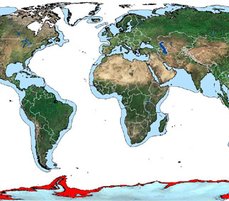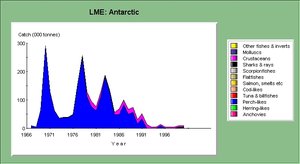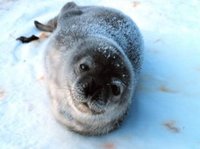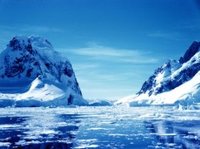Antarctica large marine ecosystem
 Location of the Antarctic Large Marine Ecosystem. (Source: NOAA)
Location of the Antarctic Large Marine Ecosystem. (Source: NOAA) The Antarctic large marine ecosystem (LME) is unique both for its geographic and climatic characteristics. It is defined by the Antarctic Convergence (or Antarctic Polar Front), the boundary oscillating between 48 and 60 degrees of south latitude that separates the colder Antarctic surface waters from the warmer sub-Antarctic waters to the North. The colder Antarctic surface waters sink beneath the warmer water masses. The boundary varies seasonally and as a result of winds, currents and sea conditions. The LME is characterized by extreme weather conditions and by its ice cap, holding 70% of the earth's freshwater. The LME is considered a model for LME management.
Contents
- 1 Productivity
- 2 Fish and Fisheries
- 3 Pollution and Ecosystem Health
- 4 Socioeconomic Conditions
- 5 Governance
- 6 References
- 6.1 Articles and LME Volumes FAO, 2003. Trends in oceanic captures and clustering of large marine ecosystems—2 studies based on the FAO capture database. FAO fisheries technical paper 435. 71 pages. FAO Fisheries & Aquaculture-Large Marine Ecosystems (Antarctica large marine ecosystem) * Hempel, G, 1990. The Weddell Sea: A High Polar Ecosystem. In: Large Marine Ecosystems—Patterns, Processes, and Yields. K. Sherman, L.M. Alexander and B.D. Gold, editors. AAAS. 5-18. ISBN: 0871683849. * Hubold, G., 2003. The Antarctic Weddell Sea. In: K. Sherman and G. Hempel, Large Marine Ecosystems of the World – Trends in Exploitation, Protection and Research. Elsevier. 3-16. ISBN: 0444510273. * Scully, R. Tucker. 1993. Convention on the Conservation of Antarctic Marine Living Resources. In: Large Marine Ecosystems—Stress, Mitigation, and Sustainability. K. Sherman, L.M. Alexander and B.D. Gold, editors. AAA Press. 242-251. ISBN: 087168506. * Scully, R. Tucker, W.Y. Brown and B.S. Manheim, 1986. The Convention for the Conservation of Antarctic Marine Living Resources: A Model for Large Marine Ecosystem Management. In: Variability and Management of Large Marine Ecosytems. K. Sherman and L.M. Alexander, editors. AAAS Selected Symposium. 281-286. ISBN: 0813371457.
- 6.2 Other References
- 6.3 Citation
Productivity
One of the largest shelf areas around the Antarctic continent is found in the southern part of the Weddell Sea. The Antarctic Circumpolar Current flows around Antarctica and provides a partial return of water to the South Pacific, the South Indian Ocean and the South Atlantic Ocean. The Antarctic LME is considered a Class III, low productivity (<150 gC/m2-yr) ecosystem based on SeaWiFS annual primary productivity estimates. The low productivity is linked with extreme weather conditions, and also with the limitedlight (Sunlight) penetration due to the winter ice cover. In the Weddell Sea, the seasonal production cycle is strongly determined by ice formation in the fall and ice melting in the spring and Summer. Upwellings and cold water currents flowing around Antarctica release nutrients that cause plankton blooms. Marine species in this LME have unique ecological and biological characteristics. The base of the marine food chain is supported by about 100 species of phytoplankton. Some 200 Antarctic finfish species are found south of the Antarctic Convergence, 25% of which are unique to the area. The species of zooplankton, fish, squid, benthic organisms, seals, whales, and birds found at this latitude have sophisticated mechanisms for survival under very cold conditions. Low metabolic rates help them maintain a higher rate of protein synthesis. The food chain is very short and based almost entirely on krill (Euphausia superba), a small shrimp-like crustacean and a key species crucial to the sustainability and production of all other fisheries (Fisheries and aquaculture). Baleen whales, seals, penguins, squid, fish and seabirds all feed on krill. Reporting of data for the Antarctic LME started in 1966. The region is an international science laboratory where scientists study weather and climate, oceanography, geology and glaciology. Research activities taking place include the US Antarctic Marine Living Resources (AMLR) program. The NSF-sponsored US Long-Term Ecological Research Network has also been established.
Fish and Fisheries
 Fish catch statistics for the Antarctic LME. (Source: NOAA)
Fish catch statistics for the Antarctic LME. (Source: NOAA) There have been major fluctuations in the total catch in this LME. Total catch was 450,000 tons in 1990. Since 1992, the catch has decreased to about 100,000 tons, except from 1994 to 1996, when the catch was about 150,000 tons. There is a prevalence of demersal catches (86%), and a much smaller percentage of coastal fishes (12%). Species caught are krill, Antarctic cod, icefish, lanternfish, Antarctic squid and Patagonian toothfish. Major interest in the Antarctic’s marine living resources developed after the 1959 Antarctic treaty. Food and Agriculture Organization (FAO), has fishing statistics after 1968. In the early 1980s, krill (Euphausia superba), an epipelagic species, accounted for more than 70% of the total catch. There was a decrease of the total catch in 1983/84, after an all time high of 650,000 tons in 1982. That year, the Soviet Union harvested almost 500,000 tons of krill. When the Soviet Union dissolved in 1991, the new republics drastically reduced their fishing activities in the Antarctic. Since the 1980s, Japan has harvested 40,000 to 80,000 tons of krill a year. The decreasing total catch in recent years can be attributed to depletion, to the distance from other major fishing grounds, or to the lack of demand for some Antarctic species. There is concern for the Patagonian toothfish. Antarctic cod and icefish are now depleted. The countries involved in the commercial fishing of krill are Japan, Russia, Chile, Taiwan, Korea, Spain, Poland and Germany. The potential for overfishing has grown significantly over the last two decades. These resources are subjected to fisheries management under the Convention on the Conservation of Antarctic Marine Living Resources (CCAMLR). While landings in 1998-99 were reported at 119,898 metric tons, unregulated fishing is said to be five to six times that figure. There is thought to be a major stock of squid in this region. There is considerable interest in commercial fishing for squid by the nations already catching krill in the Antarctic. The University of British Columbia Fisheries Center has detailed fish catch statistics for this LME. A graph is provided below.
Pollution and Ecosystem Health
 (Source: Rear Admiral Harley D. Nygren, NOAA Corps (ret.) NOAA)
(Source: Rear Admiral Harley D. Nygren, NOAA Corps (ret.) NOAA) Overfishing may become an issue. While the Antarctic LME is remote, and has no native coastal populations, it is a fragile environment in which there is growing pressure from human activity. Strict regulation is needed to maintain its untouched and pristine condition. The impacts of human activities are explored at the Ohio State University website. This examines the effects of tourists and scientists at laboratory stations, and the potential impacts of oil exploration and mining activities. Tourists must follow a strict code of environmental conduct. Whaling and sealing were massive human impacts around [[Antarctic]a]’s islands. There are indirect impacts on this LME due to anthropogenic environmental change. Scientists have uncovered a hole in the ozone layer. In 1997, researchers found that increased ultraviolet light coming through the hole was damaging the DNA of icefish, an Antarctic fish lacking hemoglobin. Increased UV radiation has a negative impact on surface phytoplankton productivity. Various taxa are sensitive to UV radiation. In 1998, National Aeronautics and Space Adminstration (NASA) satellite data showed that the Antarctic ozone hole was the largest on record. There have been scientific discussions on climate change and the recent collapse of ice shelves.
Socioeconomic Conditions
The Antarctic continent has no indigenous inhabitants. Whaling activities took place between the 1930s and the 1980s. See “Fish and Fisheries” for a description of foreign fishing fleets harvesting marine resources and specifically krill in the Antarctic LME. Krill while easy to catch are very perishable and must be processed quickly. The problem with krill is finding a market that can absorb large quantities at a price that can match the high costs of working in the Antarctic environment. Scientists live in research stations on a seasonal basis to study weather and climate, oceanography, geology and glaciology. 10,013 tourists visited Antarctica in 1999, up from 9,604 the previous year. Nearly all of them were passengers on commercial ships and yachts. Most tourist trips last approximately two weeks. No other economic activities are taking place. Iron ore, chromium, copper, gold, nickel, platinum, coal and hydrocarbons have been found in this region but are not being exploited (see “Governance”). The continent holds 75% of the earth's freshwater. This is an important resource given the depletion and pollution of freshwater elsewhere.
Governance
 (Source: Commander John Bortniak, NOAA Corps (ret.) NOAA)
(Source: Commander John Bortniak, NOAA Corps (ret.) NOAA) [[Antarctic]a] and the surrounding waters have a special status that required international cooperation. 7 countries originally made claims on Antarctica: England (1908), New Zealand (1923), France (1924), Australia (1933), Norway (1939), Chile (1940) and Argentina (1943). International cooperation takes place within the framework of the Antarctic Treaty. The region covered by the Treaty is situated south of 60 degrees South latitude. The Treaty came into force in 1961 after ratification by the twelve countries then active in Antarctic science. Today 44 countries have ratified the Treaty. Its objectives are unique in international relations: to demilitarize Antarctica and establish it as a nuclear-free zone; to use it for peaceful purposes only; and to promote international scientific cooperation. There are special agreements pertaining to Antarctica’s resources and its environmental protection. The Convention on the Conservation of Antarctic Marine Living Resources (CCAMLR) was established to manage the LME’s living marine resources using an [[ecosystem]s] approach. Its international and ecological approach is a milestone in the conservation and management of living marine resources. Measures have been adopted by CCAMLR to monitor and assess the level of marine debris from fishing vessels and the impact on marine living resources. There is a ban on oil exploration. Other conventions affecting Antarctica are: Agreed Measures for the Conservation of Antarctic Fauna and Flora (1964); the Convention for the Conservation of Antarctic Seals (1972); the Convention on the Regulation of Antarctic Mineral Resource Activities (1988); the Protocol on Environmental Protection to the Antarctic Treaty (1991); and the Convention on the Regulation of Mineral Resource Activities (CRAMRA, 1991), which is a ban on oil and mineral exploration to last for 50 years. The Protocol on Environmental Protection entered into force in 1998 and includes an annex on waste disposal and waste management. But these restrictions could be difficult to enforce.
References
Articles and LME Volumes FAO, 2003. Trends in oceanic captures and clustering of large marine ecosystems—2 studies based on the FAO capture database. FAO fisheries technical paper 435. 71 pages. FAO Fisheries & Aquaculture-Large Marine Ecosystems (Antarctica large marine ecosystem) * Hempel, G, 1990. The Weddell Sea: A High Polar Ecosystem. In: Large Marine Ecosystems—Patterns, Processes, and Yields. K. Sherman, L.M. Alexander and B.D. Gold, editors. AAAS. 5-18. ISBN: 0871683849. * Hubold, G., 2003. The Antarctic Weddell Sea. In: K. Sherman and G. Hempel, Large Marine Ecosystems of the World – Trends in Exploitation, Protection and Research. Elsevier. 3-16. ISBN: 0444510273. * Scully, R. Tucker. 1993. Convention on the Conservation of Antarctic Marine Living Resources. In: Large Marine Ecosystems—Stress, Mitigation, and Sustainability. K. Sherman, L.M. Alexander and B.D. Gold, editors. AAA Press. 242-251. ISBN: 087168506. * Scully, R. Tucker, W.Y. Brown and B.S. Manheim, 1986. The Convention for the Conservation of Antarctic Marine Living Resources: A Model for Large Marine Ecosystem Management. In: Variability and Management of Large Marine Ecosytems. K. Sherman and L.M. Alexander, editors. AAAS Selected Symposium. 281-286. ISBN: 0813371457.
Other References
- Chopra, S. and C. Hansen, 1997. Deep ecology and the Antarctic marine living resources: lessons for other regimes. Ocean and Coastal Law Journal. 3(1-2):117-148.
- Compendium of Antarctic Peninsula Visitor Sites—a report to the Governments of the United States and the United Kingdom. 1997. 243 pages, with a bibliography.
- El-Sayed, S.Z., ed. 1993. The Antarctic marine ecosystem in global perspective. Chapter 21, pp. 363-375. In Southern Ocean ecology--The Biomass Perspective. Cambridge Univ. Press, Cambridge, UK. IUCN Antarctic Advisory Committee background document. 1996. 49 pages. ISBN: 0521443326.
- Lack, M. and G. Sant, 2001. Patagonian toothfish: are conservation and trade measures working? Traffic Bulletin. 19(1):15-32.
- NASA, 1992. Arctic and Antarctic Sea Ice, 1978-1987. Satellite passive-microwave observations and analysis.
- Nicol, S. and Y. Endo, 1999. Krill fisheries development, management and ecosystem implications. Aquatic Living Resources, 12(2):105-120.
- NOAA. 1991. Report of the ad hoc Committee on Large Marine Ecosystems. NOAA Technical Memorandum NMFS-F/NEC-92, 19p.
- Sherman, K. and A.F. Ryan. Antarctic marine living resources. Oceanus, 31(2): 59-63.
| Disclaimer: This article contains certain information that was originally published by the National Oceanic and Atmospheric Administration (NOAA). Topic editors and authors for the Encyclopedia of Earth have edited its content and added new information. The use of information from the NOAA should not be construed as support for or endorsement by that organization for any new information added by EoE personnel, or for any editing of the original content. |